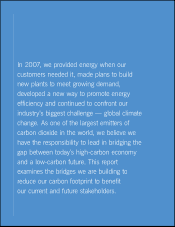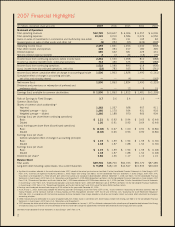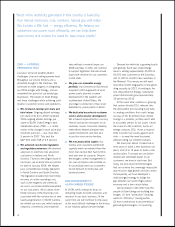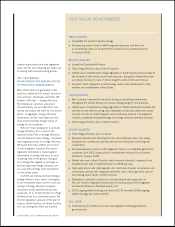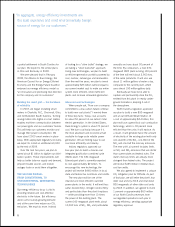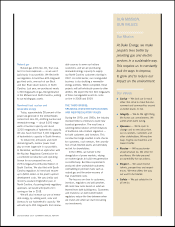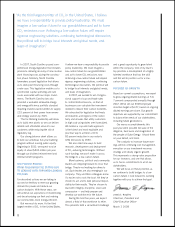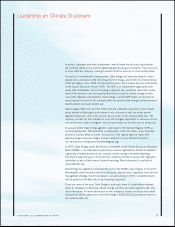Duke Energy 2007 Annual Report Download - page 8
Download and view the complete annual report
Please find page 8 of the 2007 Duke Energy annual report below. You can navigate through the pages in the report by either clicking on the pages listed below, or by using the keyword search tool below to find specific information within the annual report.
6
a partial settlement in South Carolina for
our plan. We expect to file similar plans
in Ohio and Kentucky in 2008.
We were pleased that in February
2008, the Alliance to Save Energy, the
American Council for an Energy-Efficient
Economy and the Energy Future Coalition
endorsed our energy efficiency model as
“an innovative and promising new direction
for the company and its customers.”
Building the smart grid — the backbone
of reliability
In 2007, we began installing smart
meters in Charlotte, N.C., Cincinnati, Ohio,
and northwestern South Carolina. Turning
analog meters into digital or smart meters
enables real-time communication between
our power grids and our customers’ homes.
This will help our customers monitor and
manage their power consumption. We
have about 7,500 smart meters in place
today. With appropriate regulatory recovery,
we expect to install an additional 60,000
by the end of 2009.
Over the next five years, we plan to
spend about $1 billion to digitize our distri-
bution system. These improvements will
help us better balance supply and demand,
pinpoint trouble sooner, and restore
outages faster or avoid them altogether.
THE SECOND BRIDGE:
FROM CONVENTIONAL TO
UNCONVENTIONAL GENERATING
TECHNOLOGIES
Our energy efficiency focus is vital to
providing reliable and cost-effective
electricity in the future. But efficiency
alone cannot satisfy growing demand
and at the same time reduce our CO2
emissions. We must do more. Instead
of looking for a “silver bullet” strategy, we
are taking a “silver buckshot” approach.
Using new technologies, we plan to build
an efficient generation portfolio powered by
coal, nuclear, natural gas and renewables.
Over the next five years, we plan to invest
approximately $23 billion (almost equal to
our current market cap) to make our entire
system more efficient, retire inefficient
plants and increase renewable generation.
Advanced coal technologies
When people ask, “How can a company
committed to a low-carbon future continue
to build new coal plants?” I remind them
of these key facts: Today, coal accounts
for about 50 percent of our nation’s total
electric generation. In the United States,
Duke Energy’s system is about 70 percent
coal. We burn coal today because it is
the most abundant and economical fuel
available for large-scale reliable power
generation. We are finding ways to use
coal more efficiently and cleanly.
Indiana regulators approved our
four-year plan to build a cleaner-coal
integrated gasification combined cycle
(IGCC) plant. The 630-megawatt
Edwardsport plant is currently expected
to cost approximately $2 billion. To
encourage this new technology, the
project will receive $460 million in local,
state and federal tax incentives and credits.
The new plant will be one of the
cleanest and most efficient coal-fired
power plants in the world. It will emit less
sulfur dioxide (SO2), nitrogen oxides (NOX)
and particulates than the plant it replaces
— while providing more than 10 times
the power of the existing plant. The
current 160-megawatt plant emits about
13,000 tons of SO2, NOX and particulates
annually and runs about 30 percent of
the time. By comparison, a new 630-
megawatt IGCC plant running 100 percent
of the time will emit about 2,900 tons
of the same pollutants. It will also use
about 11 million gallons of water a day,
compared to the current plant, which
uses almost 190 million gallons daily.
Eventually we hope to be able to
capture and permanently store the CO2
emitted from this plant in nearby under-
ground formations, keeping it out of
the atmosphere.
North Carolina regulators approved
our plan to build a new 800-megawatt
unit at our Cliffside Steam Station. At
a cost of approximately $2.4 billion, this
plant will use supercritical coal-combustion
technology, which is 30 percent more
efficient than the units it will replace. As
a result, it will generate twice the amount
of electricity of the existing plant with only
one-seventh of the SO2, one-third of the
NOX and one-half the mercury emissions.
The new unit’s air permit includes limits
on SO2 and NOX emissions that are stricter
than current state and federal rules. The
state’s mercury limits are already more
stringent than federal rules. The project
will receive $125 million in federal clean-
coal tax credits.
We also agreed to implement a unique
CO2 mitigation plan for Cliffside. As part
of that plan, we will retire the plant’s four
older coal units by 2012 and shut down
800 megawatts of other older coal units
by 2018. In addition, we agreed to invest
1 percent or approximately $50 million
of our North Carolina revenues from
our regulated operations each year in
energy efficiency, pending appropriate
regulatory approval.
“In aggregate, energy efficiency investments are
the least expensive and most environmentally benign
source of energy for our customers.”


